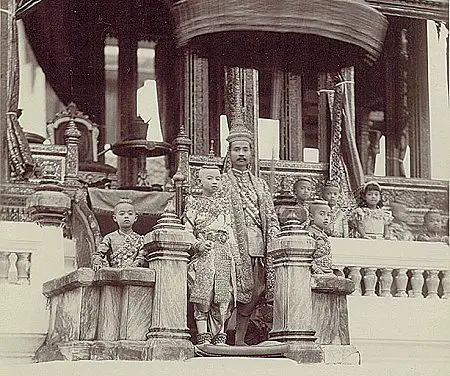 I like to read books that not only provide an entertaining reading experience but also give the readers an insight into bygone eras. By that I don’t necessarily refer to historical fiction, but rather to novels (most of which fall under the genre of literary fiction) that incorporate in their prose snippets of information about a specific historical age. One such novel that masterfully presents the atmosphere of 19th century Siam is The Occidentals by Caron Eastgate James, a book of love, hate, betrayal and vengeance that brings together the East and the West. The book was published in 1999 by Asia Books.
I like to read books that not only provide an entertaining reading experience but also give the readers an insight into bygone eras. By that I don’t necessarily refer to historical fiction, but rather to novels (most of which fall under the genre of literary fiction) that incorporate in their prose snippets of information about a specific historical age. One such novel that masterfully presents the atmosphere of 19th century Siam is The Occidentals by Caron Eastgate James, a book of love, hate, betrayal and vengeance that brings together the East and the West. The book was published in 1999 by Asia Books.
Caron Eastgate James (now Dann) lived in Bangkok from 1990-1993 and from 1997-1999, but currently resides in Melbourne. During her time in Thailand, she spent a lot of time among the books in the library at The Siam Society, where she found the materials needed for her novel and future doctoral thesis. In 2007, she graduated from Monash University with a PhD in literary studies. She specialized in Western writing about Thailand from Marco Polo to today and her non-fiction book, Imagining Siam: A Literary Travellers’ Guide to Thailand, published by Monash Asia Institute in 2008, is the result of her research. Caron Eastgate is also a print-media journalist and travel writer who has worked in New Zealand, Australia and Thailand and currently works as a lecturer. The Occidentals is her first novel and, on the last page of the book, she promises to write two more in a series to complete a trilogy.
The Occidentals is divided into three parts, each part following the destiny of a British-Siamese family over a period of three generations. In Part One (February 1869 – August 1869), the reader is introduced to the main characters and the flaws that would eventually brings about their demise. Edward Fairburn, a British adventurer with a passion for photography, travels to the Far East with the intention “to photograph the kingdom of Siam and its inhabitants.” He leaves behind, in Australia, his wife, Charlotte and his seven-year-old daughter, Elisabeth.
Edward is enthralled by what he finds in Siam and soon makes the kingdom his new home: “There were strange fruits he had never seen or heard of before: the red spiky rambutan, the smooth-skinned green or yellow mango, the huge jackfruit, and the foul-smelling but highly-prized durian.” It is the Siam of King Maha Mongkut’s reign and Edward’s ambition to make a name for himself as the king’s photographer heavily weights against returning to his family.
It is here, in the capital city of Siam, where Edwards meets Kesri, a Thai woman from a poor family, who soon becomes his mistress. Realizing that he will need more time to fulfill his dreams as a photographer, Edward suggests to Charlotte that she return to England with Elizabeth. However, after more than a year apart, they join Edward in Siam, thus triggering a series of events that will eventually shape the destinies of their future generations.
Although Kesri considered herself more than just Edward’s servant, with the arrival of his family things changed: “Their relationship was based on sensual pleasure and little more. On the rare occasions he would initiate a sensitive conversation, particularly with any regard to herself, her family, or her past, she would smile beguilingly, slip off her panung, and that would be the end of it.” After Kersi remains pregnant and Edward moves her out of the house they were all sharing, Kesri decides to let Charlotte know the truth about her relationship with Edward. This only further complicates the situation and, eventually, Charlotte leaves Siam while Elizabeth remains with her father and her newly born half-sister, Anchalee.
In Part Two (April 1882 – November 1886), the reader is introduced to a few new characters that would shape the destiny of Edward’s two daughters. By now, Edward Fairburn has become “one of Bangkok’s most prosperous photographers,” and on her return to Siam from England, where she went to school, Elizabeth rekindles her relationship with Anchalee. But, upon entering in the possession of a letter written by Kesri before she was thrown out by Edward, Anchalee swears to revenge her mother, thus setting the stage for years of bitterness between the two sisters: “Anchalee’s not a meek little girl. She’s a woman with a generation of hate behind her, and she’s carrying out a vendetta against Elizabeth as revenge for something she thinks happened years ago.”
The third and last part of the novel (February 1904 – May 1905) follows the consequences of two generations of “too much unhappiness, too much deceit, and too many betrayals.” In the fashion of Victorian romance, the plot further complicates when the third generation of Fairburns are affected by events that took place during their grandparents’ time.
In The Occidentals, Caron Eastgate James succeeds in portraying the Siamese capital of the 19th century with flavour and accuracy. The small community of expatriates also becomes the focus of her scrutiny, while the reader is also given a glimpse into the life of the extended Siamese royal family. Also, the vivid descriptions of the Western fashion of the time are in deep contrast with the more simplistic dress code of the common Siamese.
To advance the action and to provide background information on the characters and the places they visit, the author makes brilliant use of letters send by the main characters to family and friends back home. Also, whole paragraphs taken from a travel book written by one of the main characters, give us a better understanding of what Siam was like for the Westerner travelers.
The Occidentals is a well-researched novel that is littered with accurate historical trivia that give a special flavour to the prose and help the Western reader relate to a faraway culture. Thus, we find out about John Chandler (the first person who journeyed up the Chao Phraya River by steamboat), Anna Leonowens (a governess at the king’s court), Louis Leonowens (Anna’s son and a captain in King Chulalongkorn’s army) plus many more.
As the readers go through the novel, they witness several milestones in the history of Siam, with a focus on the history of photography and the subsequent interest in this art by the royal family: “From the first lesson, King Chulalongkorn was entranced with the gentle art of photography, and his intelligence and creative spirit had seen him master the basics much sooner, Edward had to admit, than he had done so himself.” Also, mentions of the danger of colonial threat (which the Siamese court masterfully avoided) lurk in the background and the modernizations the country eventually undergoes give the readers a feeling of place and create a historically valid novel.
Photo source 1 & 2




Thank you for your extensive review of my book and for going to the trouble of finding out some details about me.
the book says a possible trilogy
any other following books ??????/